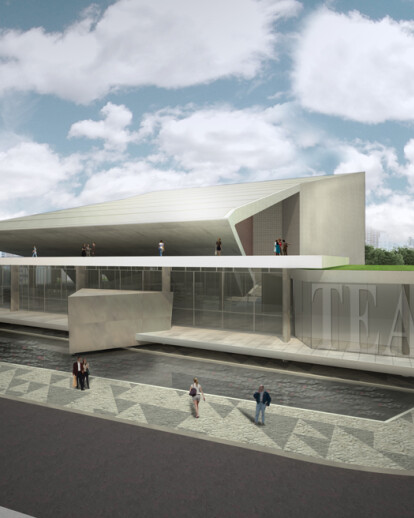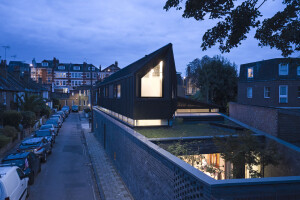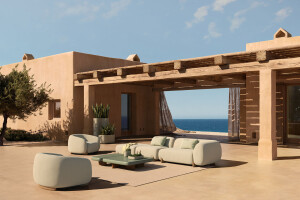[a broadcast for CULTURAL LIFE]
A theatre is part of those initiatives that play an essential role in a people’s cultural life. With its public character, by definition, sites where performances take place have in fact a significant function in the structuring of cities and territories which they irrigate culturally. The NTCA will become a place where Bahia’s art history and cultural production will be exposed. There will be flows of people through galleries that will function as a didactic space by exposing the production and development made to the building. By creating a link with art, the NTCA will replicate its actions to other places, becoming a cultural diffuser promoting endless activities: a synergy camp, open to different art expressions, containing areas dedicated to performances and production; it will be multifunctional and well equipped.
[the PARTY and project strategy]
The project attends the proposition to intervene in so-called three levels: REQUALIFICATION, REALLOCATION and ADDITION. A strict chronogram, divided in steps, will be followed for the retrofit, focused on maintaining the NTCA functioning during the construction, having as a warranty its feasibility and the proposition for future partnerships. The architectural party was created with two strategies in mind: the preservation of the existing volume and the construction of a new evolving topography – an extension of the city’s territory – organizing the flows from the main accesses and the communicability of its functions. An extension of the level of city’s public circulation is created through a plaque that intercepts the existing theater volume and enlarges it on a suspended garden. The negative spaces are occupied, thus giving strength to the idea of creating a cover that generates shadow. The physical and functional permeability between the existing and proposed buildings make them one organism with separated systems: the technical one, which articulates the existing and proposed functional spaces; and the public one, which guarantees a flow through the exhibition galleries to the visitors.
[the strategy of MODERN PATRIMONY PRESERVATION]
The adopted strategy was to maintain and underline the strength of the original building, respecting its cultural, historical and aesthetic values and the original project created by José Bina Fonyat Filho, maintaining its integrity and design that resolve in a unique way the program in one whole volume. With this affirmation in mind it was decided to create a new topography instead of a new volume which would hold the new program without intervening with the original project. The level where the foyer is located was adopted as this new relief, working as a detached pavilion, as the original project once predicted. The connection between the addition and the existing building was possible by the creation of two separate flows of functional services and general public, establishing a coherent and balanced dialogue which brings potential to the use of the physical space.
[the PROGRAM accommodation]
The foyer, as an arriving place, is where people meet, as an extension of Campo Grande, the street and the city. Its physical integrity is preserved through the clear comprehension of the human scale that it establishes with the created square, emphasized by the main building’s volume, which becomes a line when it approximates itself to this public space. The performance starts at the foyer where the people meet and are captivated by the artistic environment they are in. The flows are organized in a way to rescue its protagonism and to re establish its importance as a permeable space, of exchange, of a sight of beauty. There, expositions, events and performances will make this space alive, in a fair homage to the architect Lina Bo Bardi, a sensitive reader and promoter of the social and artistic richness present in Brazil and Bahia. As a tribute to her, a small ‘museum’ is located where the original box office once was. To recover the original foyer’s transparency, it is suggested that the panel by Caribe were transferred to the memorial area, where it will be visible by all visiting public of the complex. A new esplanade makes it possible for the foyer to extend itself and makes a connection with the free span below the main auditorium, valuing and transforming it into an articulating space of the different levels, where a bleacher / stairs enlarge its volume and encourage artistic performances. The infrastructure of the foyer’s terrace was reviewed to support the new activities proposed and then become a natural extension of it, which brings a better relation between the city and the NTCA itself.
At the so called “Café Teatro” [theater cafe] the original design was intended to be recovered, but adapted to contemporary needs, as it was once a perfect fit to the foyer.
The main room, dressing room and the stage support areas were redistributed, for a clearer organization. The stage area will have the requested requalification, to meet more freely the scenic changes. The audience will be reorganized, for both allocation of seats and for finishes, according to the most modern materials and techniques of acoustic treatment.
A medium sized theater of multiple use, the choir room is a place for words and has a need to be more intimate, creating a relationship of proximity and interaction between the staging area and the public, allowing the public to see the artists’ eyes, to feel their breath. Its original location is disadvantageous to it, for it was in the back of the complex. The NTCA’s circuits’ new organization, combined with the creation of a specific foyer, located over a new parking lot that allows direct boarding and landing, guarantees a better visibility from the outside, consistent with its importance as a performing space for the emerging theater of Bahia.
For the two stable bodies, OSBA [Bahia’s Symphonic Orchestra] and BTCA [Castro Alves Theater’s Ballet], a complete reorganization of their spaces is proposed, with physical structures more compatible with an artistic production focused on excellence. The NEOJIBA [Bahia’s New Young Orchestra] was moved to the floor -1, to find better, more appropriate and comfortable accommodation, located in a suitable place near the stage and the collective dressing rooms, something that will encourage social inclusion projects through orchestral music. The proposal for the “Centro de Referência em Engenharia do Espetáculo Teatral”, CREET [Theater Performance Engineering Reference Center], is based on fluidity of space, visual permeability and smooth operation of the activities pertaining to scenography. Considering scenography as a process, successive workshops and related activities were chosen; a permeable path designed for professionals who work there, and occasionally for the viewer / spectator, who will have a perspective of what might be called the 'inside' of a show. The warehouses are to be opened visually through a large, transparent shelf. From this space where materials are held it is possible to see the workshop in the background. The exposition character is present in both Workshops and Research Center. Everything that can contribute to the understanding of the theatrical process is exposed: wardrobe, costume workshop, workshops for carpentry, metalwork and props. The Experimental Theater, at the end of this path, opens frankly to a small inner square. This square, this void, comes from the importance to stand at a distance and have the understanding of the whole – the spectacle as a whole, while being created. When walking around the space, servers, visitors and guests make contact with both the history of the building and with what it produces in its facilities, a living laboratory circuit, with activities that communicate experiences, a teaching / learning, expositive space on a walking path.
The Experimental Theater, or multipurpose space, presents the design of a flexible theater, ready to meet a demand for a number of other possibilities related to theater, giving possibility to organize the space according to specific needs. It provides references to the ephemeral character of the show, with an opening for the social space and art, organizing workshops and educational activities as a way to connect the public, artists and the community. This approach aims to encourage collaborations among artists from all areas, thanks to an architecture capable of generating porosity among disciplines. With the intention to occupy all interstices available in the building, considering them all as a scenographical support to the creation process, its transparency aims to expose the movement to the eyes of the passersby and to offer work conditions with natural light for the artists. It removes the idea of ‘the stage and the room’, to change them into a unique place, without any walls or barriers, which will become an actual stage for action and an infinite range of occupations. A direct communication can be established between the spectator and the theater, between the actor and the spectator; through the fact that the spectator, placed in the middle of the action, is involved and permeated by it.
The interventions and proposals for the CREET are to provide it with equipment capable of placing it, in fact, as a reference in the national and international performing arts, and more than a receptor, to make it a sponsor of many different artistic expressions. In one hand is the information, the movement of ideas, and on the other, the provision of services. Joining these activities in a single area in the country, will ensure the originality requested, where all the technical knowledge, information and practices will be able to structure and integrate the elements of the show, which will enhance its role as a point of identity and connection between Salvador, Bahia, Brazil and the world. The space of the new acoustic shell was understood as the territory of the great spatial opportunities, resuming its important role as an alternative cultural field in Salvador. A walkway connects the NTCA, from the access level of the Choir, to its similar level across the valley, connecting the edges and allowing a new access to the new building, in a more complete urban articulation. The covering of the stage hangs from this walkway and lightweight structures support the folding cover of the audience which, on the other end, rests on the new balconies. It is onto this valley, with a perspective view to the city, that the new CREET installations open themselves, obedient to the architectural party of maximum visualization of its activities. The bottom of the valley receives a treatment that organizes its functions and flows, from the stage and activities courtyard to the loading and unloading docks. This occupation allowed to fully preserve the mass of vegetation on the opposite slope from the NTCA building.
Along the length of the rear façade of the theater, and taking advantage of the topography, the parking lot was installed. The proposal meets what was required by the program, but a very workable solution will allow twice as many parking places than what was required, thus facilitating its commercial exploitation. The bicycle racks have been strategically positioned to better receive the flow of this type of vehicles, considering its existence as an opportunity to encourage changes in the transport mode of the population.





























